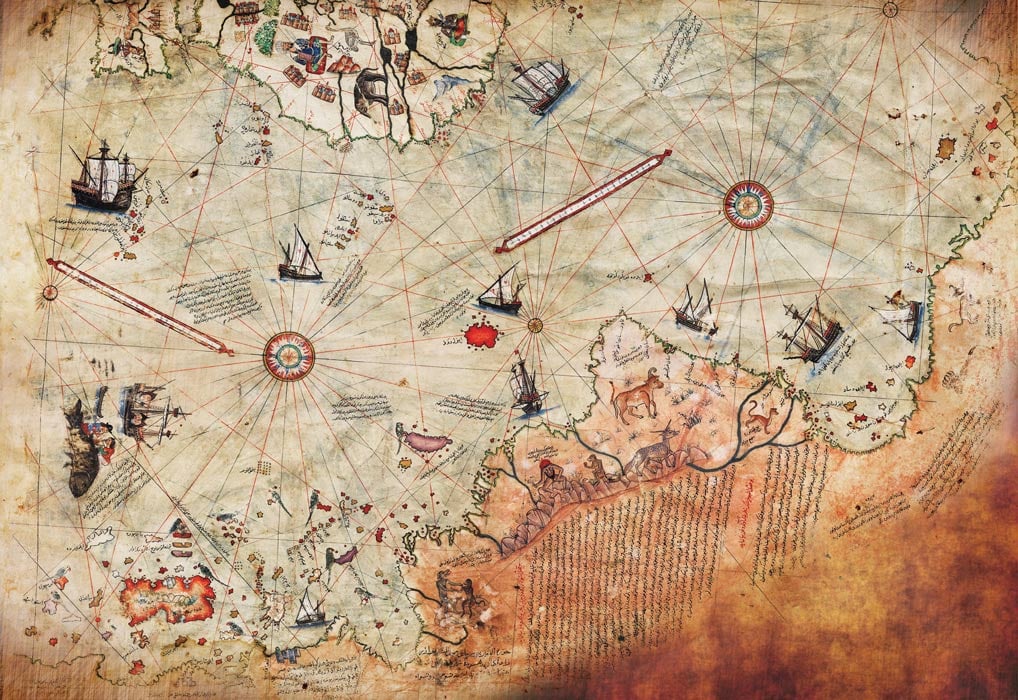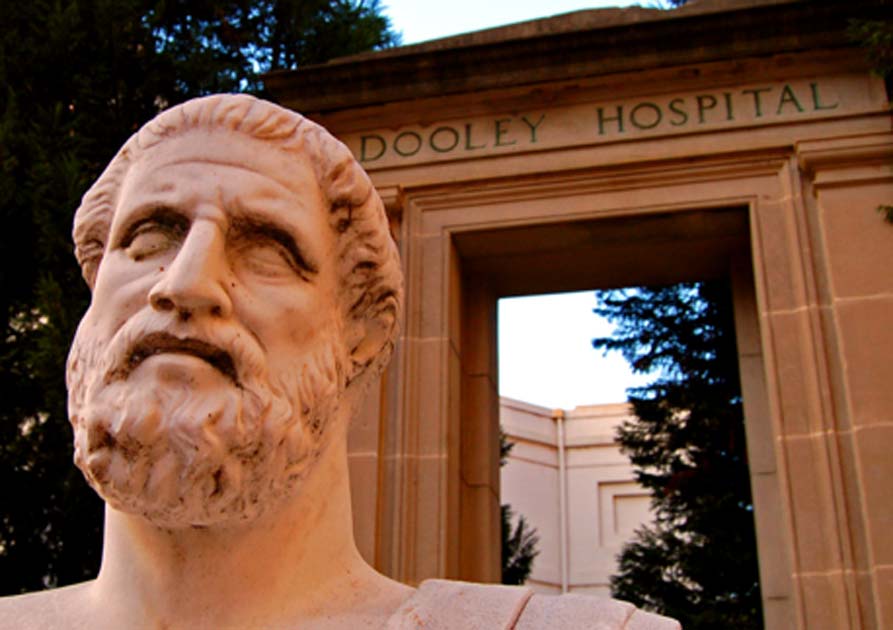via Interesting Literature

Of all Shakespeare’s plays, Timon of Athens is perhaps the most easy to summarise in terms of its plot; certainly it’s up there in the top five of his plays with the simplest plot which can be summarised in just a few sentences. So we’ll keep the following plot summary brief.
Continue reading
==============================
Piri Reis Map - How Could a 16th Century Map Show Antarctica Without Ice?
via Ancient Origins by Beth

The Piri Reis Map. Credit: Mehmetilker / Adobe Stock
On October 9, 1929, a German theologian named Gustav Adolf Deissmann was cataloguing items in the Topkapi Palace library in Istanbul when he happened across a curious parchment located among some disregarded material. On the gazelle skin parchment was a map, now referred to as the Piri Reis map .
The map was drawn and signed by Turkish cartographer Hagji Ahmed Muhiddin Piri , aka Piri Reis, and is dated to 1513 AD. Reis was an admiral in the Turkish navy, an experienced sailor, and a cartographer, who claimed to have used 20 source maps and charts to construct the map, including 8 Ptolemaic maps, 4 Portuguese maps, an Arabic map, and a map by Christopher Columbus.
Continue reading
==============================
Lithium: A Doctor, A Drug, And A Breakthrough
via 3 Quarks Daily by Morgan Meis by A J Lees at Literary Review:
Lithium is a silvery-white metal that is so light it can float on water and so soft it can be cut with a butter knife. Along with hydrogen and helium it was produced during the Big Bang and so formed the universe before the emergence of the galaxies. It is employed to harden glass and to thicken grease, but its best-known industrial use is in the manufacture of rechargeable batteries. Lithium salts are found in considerable quantities in brine and igneous granite and the element is present in trace quantities in the human body. Lithium is also one of the few metals – along with platinum for cancer, gold for rheumatoid arthritis and bismuth for dyspepsia – that are used as medicines.
Continue reading
==============================
10 of the Best Poems about Graveyards
via Interesting Literature
Death looms large in poetry, from epitaphs to poems of grief over the loss of a loved one. And, of course, there’s a long-standing tradition of religious or sacred poems. But what about churchyards, graveyards, and cemeteries – those spaces around the church filled with the dead, with epitaphs by turns moving and cringeworthy, with yew trees and with flowers brought in memory of the deceased? Below we attempt to introduce ten of the very greatest poems about churchyards.
Continue reading
==============================
The fever tree
via The Royal Society Repository blog by Melody Bishop

Cinchona of St Lucia: plate 19 from ‘An account of a new species of the Bark-tree, found in the Island of St Lucia’ by George Davidson, Philosophical Transactions of the Royal Society, vol.74 part 2 (1784), pp.452-456.
In summer 2018, I was the sole Undergraduate Research Assistant for a project entitled ‘The Fever Tree’. This initiative, jointly run by Dr Marc Etherington (Physics) and Dr David Lowther (History) at Durham University and sponsored by the Hatfield Trust, aimed to understand the changing interest in quinine and divergent routes of study throughout the nineteenth and twentieth centuries.
My main responsibility during this internship was to transcribe nineteenth-century scientific correspondence. The aim was to analyse how the study of quinine – a compound derived from the bark of the cinchona tree and the key component of tonic water – changed over time, ultimately resulting in quinine’s reputation as a valuable antimalarial and fluorescence standard.
Continue reading
==============================
Be My Matelotage! The Civil Union of 17th Century Pirates
via Ancient Origins by B.B. Wagner

Matelotage is the marriage / civil union of two male pirates. Source: rdrgraphe / Adobe Stock.
Love strikes hard like the broadsiding from a warship, leaving both splinters and buckshot in one’s heart. When it hits, there's nothing anyone can do but accept the bombardment with both arms open. It can happen with friends, co-workers, and even with 17th-century Caribbean pirates . The word 'matelotage’ carried many different meanings, but in the island of Tortuga, matelotage meant the civil union and sexual relationship between two pirate men.
In 1645, the French-controlled island of Tortuga was a safe haven for privateers and buccaneers alike. Tortuga was also a sanctuary for those who wished to have matelotage, the civil union of two male pirates.
Continue reading
This is quite a long read but I found it very interesting. It told me about things I had not previously known.
==============================
How archives helped solve a family mystery
via The National Archives Blog by Kerri Ramsay
Like many of us who find ourselves working at The National Archives, I have a passion for both mysteries and social history. This is the story of how I solved a family mystery of my own – of who really was my estranged great-grandfather? – with a little help from some historical documents.

Robert John Davidson in a locket pendant photograph
I began my investigation armed with a few random facts that had been passed down through the years. I knew that his name was Robert John Davidson; that he had been married with children to a lady named Catherine; that he was an excellent horse rider; that he had served in the Great War with the Lovat’s Scouts regiment; and that he was buried on the Rothiemurchus estate in Scotland. Finally, perhaps less appealingly, there was the rumour that he had been seeing another woman at the same time as my great-grandmother!
Continue reading
==============================
An Interesting Character Study: Lady Macbeth
via Interesting LIterature
Lady Macbeth is widely regarded as one of the most villainous female characters in all of English literature, and perhaps Shakespeare’s most cold-hearted female character. Not only does she urge her husband to murder their King for no other reason than heartless ambition, she also states that she would dash out her own baby’s brains rather than lose her courage for such a regicidal act.
Continue reading
==============================
The Intelligence of Plants
via Arts and Letters Daily: Cody Delistraty at the Paris Review

MIGUEL RIO BRANCO, UNTITLED, TOKYO, 2008 © MIGUEL RIO BRANCO
What if plants are smarter than we think – a lot smarter?
A few years ago, Monica Gagliano, an associate professor in evolutionary ecology at the University of Western Australia, began dropping potted Mimosa pudicas. She used a sliding steel rail that guided them to six inches above a cushioned surface, then let them fall. The plant, which is leafy and green with pink-purple flower heads, is commonly known as a “shameplant” or a “touch-me-not” because its leaves fold inward when it’s disturbed. In theory, it would defend itself against any attack, indiscriminately perceiving any touch or drop as an offence and closing itself up.
The first time Gagliano dropped the plants – fifty-six of them – from the measured height, they responded as expected. But after several more drops, fewer of them closed. She dropped each of them sixty times, in five-second intervals. Eventually, all of them stopped closing. She continued like this for twenty-eight days, but none of them ever closed up again. It was only when she bothered them differently – such as by grabbing them – that they reverted to their usual defence mechanism.
Continue reading
==============================

Hippocrates Statue and Dooley Hospital Door .
Classical Greece is considered by many to be the birthplace of modern Western civilization. The ancient Greeks made astounding progress in a huge number of areas - from politics and governing to religious practice and philosophical thought. The impact the Hellenic culture had is still felt throughout the world today.
Archimedes, Pythagoras, Plato, Aristotle, Socrates, Homer – the list of figures from ancient Greece who have left their mark on the world today is astounding and the innovations and principles they pioneered surround us in our day-to-day lives.via Ancient Origins by Beth

The Piri Reis Map. Credit: Mehmetilker / Adobe Stock
On October 9, 1929, a German theologian named Gustav Adolf Deissmann was cataloguing items in the Topkapi Palace library in Istanbul when he happened across a curious parchment located among some disregarded material. On the gazelle skin parchment was a map, now referred to as the Piri Reis map .
The map was drawn and signed by Turkish cartographer Hagji Ahmed Muhiddin Piri , aka Piri Reis, and is dated to 1513 AD. Reis was an admiral in the Turkish navy, an experienced sailor, and a cartographer, who claimed to have used 20 source maps and charts to construct the map, including 8 Ptolemaic maps, 4 Portuguese maps, an Arabic map, and a map by Christopher Columbus.
Continue reading
==============================
via 3 Quarks Daily by Morgan Meis by A J Lees at Literary Review:
Lithium is a silvery-white metal that is so light it can float on water and so soft it can be cut with a butter knife. Along with hydrogen and helium it was produced during the Big Bang and so formed the universe before the emergence of the galaxies. It is employed to harden glass and to thicken grease, but its best-known industrial use is in the manufacture of rechargeable batteries. Lithium salts are found in considerable quantities in brine and igneous granite and the element is present in trace quantities in the human body. Lithium is also one of the few metals – along with platinum for cancer, gold for rheumatoid arthritis and bismuth for dyspepsia – that are used as medicines.
Continue reading
==============================
via Interesting Literature
Death looms large in poetry, from epitaphs to poems of grief over the loss of a loved one. And, of course, there’s a long-standing tradition of religious or sacred poems. But what about churchyards, graveyards, and cemeteries – those spaces around the church filled with the dead, with epitaphs by turns moving and cringeworthy, with yew trees and with flowers brought in memory of the deceased? Below we attempt to introduce ten of the very greatest poems about churchyards.
Continue reading
==============================
via The Royal Society Repository blog by Melody Bishop

Cinchona of St Lucia: plate 19 from ‘An account of a new species of the Bark-tree, found in the Island of St Lucia’ by George Davidson, Philosophical Transactions of the Royal Society, vol.74 part 2 (1784), pp.452-456.
In summer 2018, I was the sole Undergraduate Research Assistant for a project entitled ‘The Fever Tree’. This initiative, jointly run by Dr Marc Etherington (Physics) and Dr David Lowther (History) at Durham University and sponsored by the Hatfield Trust, aimed to understand the changing interest in quinine and divergent routes of study throughout the nineteenth and twentieth centuries.
My main responsibility during this internship was to transcribe nineteenth-century scientific correspondence. The aim was to analyse how the study of quinine – a compound derived from the bark of the cinchona tree and the key component of tonic water – changed over time, ultimately resulting in quinine’s reputation as a valuable antimalarial and fluorescence standard.
Continue reading
==============================
via Ancient Origins by B.B. Wagner

Matelotage is the marriage / civil union of two male pirates. Source: rdrgraphe / Adobe Stock.
Love strikes hard like the broadsiding from a warship, leaving both splinters and buckshot in one’s heart. When it hits, there's nothing anyone can do but accept the bombardment with both arms open. It can happen with friends, co-workers, and even with 17th-century Caribbean pirates . The word 'matelotage’ carried many different meanings, but in the island of Tortuga, matelotage meant the civil union and sexual relationship between two pirate men.
In 1645, the French-controlled island of Tortuga was a safe haven for privateers and buccaneers alike. Tortuga was also a sanctuary for those who wished to have matelotage, the civil union of two male pirates.
Continue reading
This is quite a long read but I found it very interesting. It told me about things I had not previously known.
==============================
via The National Archives Blog by Kerri Ramsay
Like many of us who find ourselves working at The National Archives, I have a passion for both mysteries and social history. This is the story of how I solved a family mystery of my own – of who really was my estranged great-grandfather? – with a little help from some historical documents.

Robert John Davidson in a locket pendant photograph
I began my investigation armed with a few random facts that had been passed down through the years. I knew that his name was Robert John Davidson; that he had been married with children to a lady named Catherine; that he was an excellent horse rider; that he had served in the Great War with the Lovat’s Scouts regiment; and that he was buried on the Rothiemurchus estate in Scotland. Finally, perhaps less appealingly, there was the rumour that he had been seeing another woman at the same time as my great-grandmother!
Continue reading
==============================
via Interesting LIterature
Lady Macbeth is widely regarded as one of the most villainous female characters in all of English literature, and perhaps Shakespeare’s most cold-hearted female character. Not only does she urge her husband to murder their King for no other reason than heartless ambition, she also states that she would dash out her own baby’s brains rather than lose her courage for such a regicidal act.
Continue reading
==============================
via Arts and Letters Daily: Cody Delistraty at the Paris Review

MIGUEL RIO BRANCO, UNTITLED, TOKYO, 2008 © MIGUEL RIO BRANCO
What if plants are smarter than we think – a lot smarter?
A few years ago, Monica Gagliano, an associate professor in evolutionary ecology at the University of Western Australia, began dropping potted Mimosa pudicas. She used a sliding steel rail that guided them to six inches above a cushioned surface, then let them fall. The plant, which is leafy and green with pink-purple flower heads, is commonly known as a “shameplant” or a “touch-me-not” because its leaves fold inward when it’s disturbed. In theory, it would defend itself against any attack, indiscriminately perceiving any touch or drop as an offence and closing itself up.
The first time Gagliano dropped the plants – fifty-six of them – from the measured height, they responded as expected. But after several more drops, fewer of them closed. She dropped each of them sixty times, in five-second intervals. Eventually, all of them stopped closing. She continued like this for twenty-eight days, but none of them ever closed up again. It was only when she bothered them differently – such as by grabbing them – that they reverted to their usual defence mechanism.
Continue reading
==============================
Ancient Greek Physician Hippocrates and the Medical Revolution
via Ancient Origins by Sarah P Young
Hippocrates Statue and Dooley Hospital Door .
Classical Greece is considered by many to be the birthplace of modern Western civilization. The ancient Greeks made astounding progress in a huge number of areas - from politics and governing to religious practice and philosophical thought. The impact the Hellenic culture had is still felt throughout the world today.
One ancient Greek whose influence is still felt the world over is Hippocrates – a physician who is widely known as the father of modern or clinical medicine. Medicine and healthcare had been practised for thousands of years. The healing properties of things such as willow bark, cannabis, and poppies were recognised and taken advantage of long before the rise of the Classical World.
Continue reading
No comments:
Post a Comment